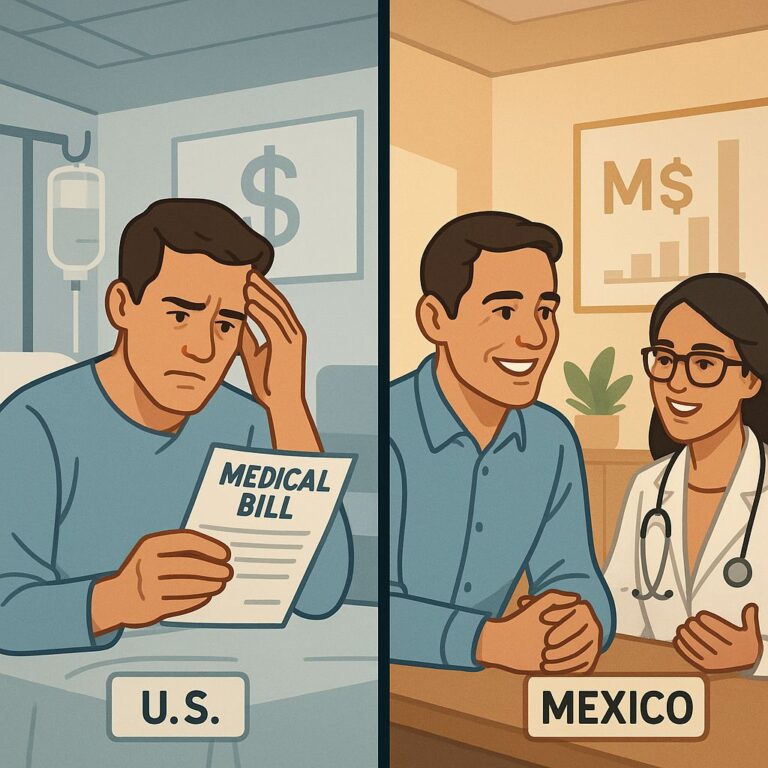Addressing the most common concerns about safety, quality and logistics.
summary
Medical travel to Mexico has emerged as a prominent option for individuals seeking affordable healthcare services, particularly for procedures such as cosmetic surgery, dental work, and bariatric surgeries. While the allure of high-quality care at signifi- cantly lower costs attracts many patients, it also raises critical concerns regarding safety, quality, and logistical challenges associated with crossing borders for medical treatment. This trend highlights the need for thorough preparation and informed decision-making to navigate the complexities of medical tourism in Mexico.
One of the primary safety concerns involves health risks, including the potenti- al for infectious diseases and environmental hazards that could impact travelers’
well-being.[1][2] Additionally, crime remains a significant issue, with varying levels of safety across different regions. U.S. government advisories often categorize certain states as high-risk areas, urging caution among travelers.[3][4] This necessitates
a comprehensive understanding of personal safety measures, including choosing reputable medical facilities and accommodations, as well as maintaining situational awareness during their stay.
The quality of medical care in Mexico is bolstered by numerous accredited healthcare facilities that meet international standards, such as those set by the American Med- ical Association and the Joint Commission International.[5][6] These establishments are increasingly recognized for their commitment to patient safety and effective treatment outcomes, which instills confidence in potential medical tourists. However, disparities in care quality can still exist, making it essential for patients to conduct thorough research and read reviews prior to selecting a provider.
Logistical challenges also pose obstacles for medical travelers, necessitating careful planning around insurance coverage, emergency services, and transportation op- tions.[4][7] With varying levels of accessibility to healthcare facilities and emergency response services, patients must ensure they are adequately prepared for any unforeseen complications. By addressing these concerns, individuals considering medical travel to Mexico can make informed choices that enhance their safety and treatment experience.
Safety Concerns
Medical travel to Mexico, while popular, raises several safety concerns that potential travelers should consider before their journey. These concerns can be broadly cate- gorized into health risks, crime, and logistical challenges.
Health Risks
Travelers should be aware of various health risks associated with visiting Mexico. Infectious diseases such as Chagas’ disease, leishmaniasis, Lyme disease, and
Zika virus can pose significant threats during travel[1]. Additionally, air pollution and conditions like leptospirosis and anthrax disease are notable concerns that may affect overall health[1][2]. Therefore, it is crucial for travelers to adopt personal protective measures and stay informed about any regional health advisories[1].
Crime and Security
Crime remains a prevalent issue in Mexico, with both violent and non-violent incidents reported across the country. Petty crime, such as pickpocketing and scams, is particularly common in tourist areas, while more serious crimes, including kidnapping and armed robbery, pose significant threats in various regions, especially outside well-trafficked areas[3][4]. U.S. government advisories indicate that certain states, including Michoacan and Guerrero, are designated as «Do Not Travel» zones due to high crime rates and violence linked to organized crime[3][8].
When navigating safety concerns, it is recommended to choose reputable accom- modations with security measures, travel in groups, and maintain a low profile
by avoiding flashy attire and jewelry[8]. Furthermore, registering with the Smart Traveler Enrollment Program (STEP) can provide valuable updates and assistance in emergencies[8][2].
Logistical Challenges
Travelers should also be cognizant of logistical challenges that could impact their safety. Emergency services in Mexico may not be as responsive or accessible as those in the United States, particularly in remote areas where medical facilities are limited[4]. Thus, it’s essential to have a plan in case of emergencies and to consider the reliability of transportation options, favoring official taxis or licensed drivers[9][4]. Additionally, the safety of public transportation should be evaluated, as overcrowded or poorly maintained vehicles can pose additional risks[9].
Quality of Care
Medical travel to Mexico is increasingly popular, with many patients seeking high-quality healthcare services at competitive prices. Central to this appeal is the adherence to international standards of care, such as those set forth by the
American Medical Association (AMA) and the Joint Commission International (JCI). These standards ensure that healthcare providers offer safe, effective, and ethical treatment options, akin to those available in the United States and other developed countries[5][6].
Accreditation and Standards
Accreditation plays a crucial role in establishing the quality of care in Mexican hospitals. Facilities such as Médica Sur and Hospital Galenia have received JCI accreditation, which is regarded as one of the highest benchmarks for healthcare quality globally. This accreditation requires hospitals to meet over 1,200 performance
standards related to patient care, safety, and infection control[10][6]. Furthermore, the Global Healthcare Accreditation (GHA) program also recognizes hospitals that excel in providing safe and effective medical services to international patients, thereby increasing patient confidence in their care options[11][12].
Patient-Centric Focus
The quality of care in Mexico is not only defined by accreditation but also by the patient experience. Many medical facilities emphasize interpersonal quality, technical expertise, and comfort, all of which contribute to a holistic approach to healthcare[13]. Patients are encouraged to research and read reviews to assess the capabilities and reputation of their chosen healthcare provider, ensuring they receive treatment from qualified professionals[14]. Moreover, hospitals often prioritize patient safety by implementing international standards that encompass effective communication, correct identification of patients, and the management of high-risk medications[15].
Outcomes and Value
Patients traveling to Mexico for medical care benefit from a combination of high-qual- ity services and lower costs. It is reported that care in accredited Mexican hospitals can be as effective as treatment in major U.S. hospitals, often at a fraction of
the price[11][14]. This blend of affordability and high standards not only meets the expectations of patients but also helps to establish Mexico as a viable destination for medical tourism, particularly for those seeking specialized treatments such as weight loss surgery, cosmetic procedures, and other elective surgeries[6][16].
Logistics of Medical Travel
Medical travel to Mexico involves careful planning and consideration to ensure a safe and effective experience for patients. The logistics surrounding medical tourism can be complex, encompassing various factors from insurance coverage to transporta- tion.
Pre-Travel Preparations
Before embarking on a medical journey, travelers should consult with their healthcare provider or a travel medicine specialist at least 4-6 weeks in advance. This pretravel consultation helps in understanding specific health risks associated with the proce- dure and the destination, as well as general advice for maintaining health during travel[17]. Additionally, it is essential to secure international travel health insurance that covers medical evacuation back to the United States, as unforeseen medical issues may arise[17].
Insurance Considerations
Travelers need to verify the details of their domestic health insurance plan, as coverage for services rendered outside the U.S. can vary significantly. Many patients
may need to purchase supplemental medical insurance, particularly for medical evac- uation services, which can be costly—ranging from $25,000 to $75,000 depending on the destination[7]. Furthermore, some facilities may charge additional fees for follow-up care, making it crucial for medical tourists to understand what services are included in the initial costs of their procedures[2].
Safety and Accommodations
Selecting the right destination is paramount for medical tourists. It is advisable to choose areas that are developed for visitors, ensuring that security is a priority[18]. Travelers should also register their trip with their consulate if staying in Mexico for an extended period, which can provide crucial assistance during emergencies[7].
Maintaining health and medical records is another critical aspect; bringing copies of relevant medical documents helps ensure that care providers at the destination are informed of any allergies or medical conditions[17].
Transportation and Medical Evacuation
The logistics of medical evacuation can be intricate, requiring not just a private flight but also pre-flight evaluations, ground transport arrangements, and coordination with local medical facilities[7]. In cases where a patient requires urgent medical attention, a dual-piloted air ambulance equipped with hospital-grade medical equipment and a qualified medical crew may be necessary to ensure safe transport[7].
Common Procedures and Services
Mexico has become a prominent destination for medical travel, offering a wide array of procedures and services that cater to both local and international patients. The country is especially noted for its advancements in cosmetic surgery and other medical specialties, attracting numerous medical tourists seeking affordable and high-quality care.
Popular Medical Procedures
Among the most sought-after procedures are:
Cosmetic Surgery: This is one of the primary reasons individuals travel to Mexico. Popular cosmetic procedures include abdominoplasty, breast augmentation, eyelid surgery, liposuction, and rhinoplasty[19][20]. Mexico’s reputation as a cost-effective destination for cosmetic surgery has contributed significantly to its medical tourism industry.
Dental Services: Dental tourism is highly prevalent, as many individuals seek afford- able dental care. Procedures such as dental implants, root canals, and cosmetic dentistry are commonly pursued by U.S. residents looking to mitigate high costs at home[21].
Orthopedic Surgery: Surgeries like hip and knee replacements are frequently per- formed in Mexico, often at a fraction of the price compared to the United States[19].
Bariatric Surgery: Mexico is a popular choice for weight loss surgeries, including gastric bypass and sleeve gastrectomy, due to lower costs and accessibility[21].
Cardiac Surgery: A variety of heart-related procedures are available, attracting pa- tients who may face long wait times or prohibitive costs in their home countries[19].
Surgical Trends
The surgical landscape in Mexico shows a strong emphasis on women’s health, with obstetric procedures and operations on female genital organs ranking among the most common. Additionally, other surgeries related to the digestive system, musculoskeletal system, and various diagnostic and therapeutic interventions are performed regularly[22][15]. According to data from SurgiScope, a significant portion of surgical procedures focuses on treating relatively basic cases, indicating an opportunity for growth in higher-level care and more complex surgical options[22].
Regulatory Framework and Safety
The Mexican government has established regulations and frameworks aimed at ensuring quality and safety in healthcare delivery. Healthcare providers are required to adhere to ethical guidelines and operational standards set forth by governing bodies, ensuring that they maintain transparency and accountability in their practices- [23][15]. However, medical malpractice complaints can be reported to the National Commission of Medical Conciliation and Arbitration (Conamed), which mediates conflicts and seeks resolutions without the need for extensive legal proceedings[24].
Post-Procedure Considerations
When engaging in medical travel to Mexico, patients must carefully consider several factors following their surgical procedures to ensure their safety and well-being.
Continuity of Care
Continuity of care is crucial after undergoing surgery abroad. Patients may require follow-up medical attention upon returning to the United States if complications arise. It is essential to understand that such post-operative care might be expensive and potentially not covered by health insurance plans[25][17]. Therefore, it is advisable for patients to confirm their insurance coverage details related to follow-up care
and consider obtaining supplemental travel health insurance to cover unexpected complications that may arise after returning home[17][26].
Air Travel Risks
Patients should be mindful of the risks associated with air travel after surgery. Flying soon after surgical procedures can increase the likelihood of developing blood clots, including deep vein thrombosis. To minimize these risks, it is generally recommended
to delay air travel for 10-14 days, especially following major surgeries involving the chest or abdomen[17].
Pre-Operative and Post-Operative Care
Patients should prioritize pre-operative consultations and medical clearances before their procedure. This may include various health assessments, such as blood tests and imaging studies, to ensure readiness for surgery[6][27]. After the surgery, a comprehensive post-operative plan should be established, including arranging for someone to assist during recovery and scheduling follow-up care with a local health- care provider, if necessary[6].
Logistics and Recovery
Planning for recovery logistics is essential. Patients should identify accommodations that allow for a comfortable recovery period, preferably close to the medical facility where the procedure was performed. Additionally, they should factor in recovery time when booking return flights[26]. Having a travel companion can be beneficial for support during the recovery phase[6][26].
Financial Considerations
It is important for patients to be prepared for upfront payments for medical services in Mexico, as most facilities do not bill insurance companies directly. Patients should familiarize themselves with the process of obtaining reimbursement from their in- surance providers for the services rendered[27][26]. Obtaining detailed treatment plans and cost estimates from chosen providers can help in managing financial expectations[26].
By addressing these considerations, patients can better navigate the post-operative phase of their medical travel experience, ultimately enhancing their overall safety and recovery outcomes.
References
- : Mexico – Medical Summary – TripPrep.com
- : Medical Tourism | Yellow Book – CDC
- : Mexico International Travel Information
- : Mexico Travel Advisory – Travel.gov
- : Staying Safe in Mexico: Travel Security Guide – MedAire
- : Mexico – Traveler view | Travelers’ Health – CDC (.gov)
- : AMA Standards of Care: Elevating Healthcare for Expats in Mexico
- : JCI Accredited Hospitals in Mexico for Weight Loss Surgery
- : Affiliations, Accreditations, Certifications and Awards [10]: Certifications Key to Attracting Patients to the Coast
11. : Accredited and Certified Organizations : Our Hospital – Hospital Galenia : Plastic Surgery in Mexico – Medical Tourism Mexico : CSG Accreditation in Mexico – Health Tourism : National and International Certifications – Grupo Médico Costamed : Medical Tourism: Travel to Another Country for Medical Care : How To Deal With A Medical Emergency in Mexico | AirCARE1 : Is it safe to travel to Mexico for medical tourism : Complete Guide to Medical Tourism in Mexico [20]: Medical Tourism | CDC Yellow Book 2024
- : Booking Medical Treatment in Mexico – Health Tourism
- : The Most Popular Surgical Procedures in Mexico
- : Healthcare enforcement & litigation in Mexico – Lexology
- : How to file a medical malpractice lawsuit | Abogados de Negligencia
- : Navigating medical tourism among your patient population – MDLinx
- : Medical Tourism in Mexico: Planning, Payment, Preparation – Mexpro
- : Medical Tourism Frequent Questions




